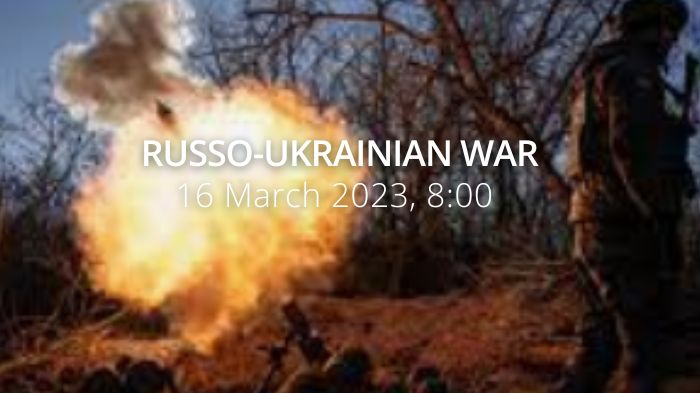Russian forces launched 3 missile and 24 air strikes, and launched more than 80 MLRS attacks, hitting 20 settlements. Ukrainian forces continued the counteroffensive in the directions of Svatove and Kreminna. Russian forces conducted offensive operations to constrain Ukrainian forces. Russian forces continued defensive operations along the Dnipro River and continued to conduct ground assaults near Bakhmut and Donetsk City. Russian occupation authorities continued to forcibly relocate Kherson and Zaporizhzhia Oblast residents. They nationalize Ukrainian enterprises in occupied territory, and forcibly deport Ukrainian children to Russia. Russian officials announced that occupation authorities began integrating the Zaporizhzhia Nuclear Power Plant (ZNPP) into Russian jurisdiction. The Russian Federation Foreign Ministry issued a statement “on preventing nuclear war." The United States allocated $55 million to Ukraine to repair and maintain the heat supply infrastructure.
Daily overview — Summary report, November 3
A map of the approximate situation on the ground in Ukraine as of 00:00 UTC 03/11/22.
There have been no notable changes to control since the last update. pic.twitter.com/v4UwY19q5l
— War Mapper (@War_Mapper) November 3, 2022
The General Staff’s operational update regarding the Russian invasion as of 06.00 am, November 3, 2022 is in the dropdown menu below:
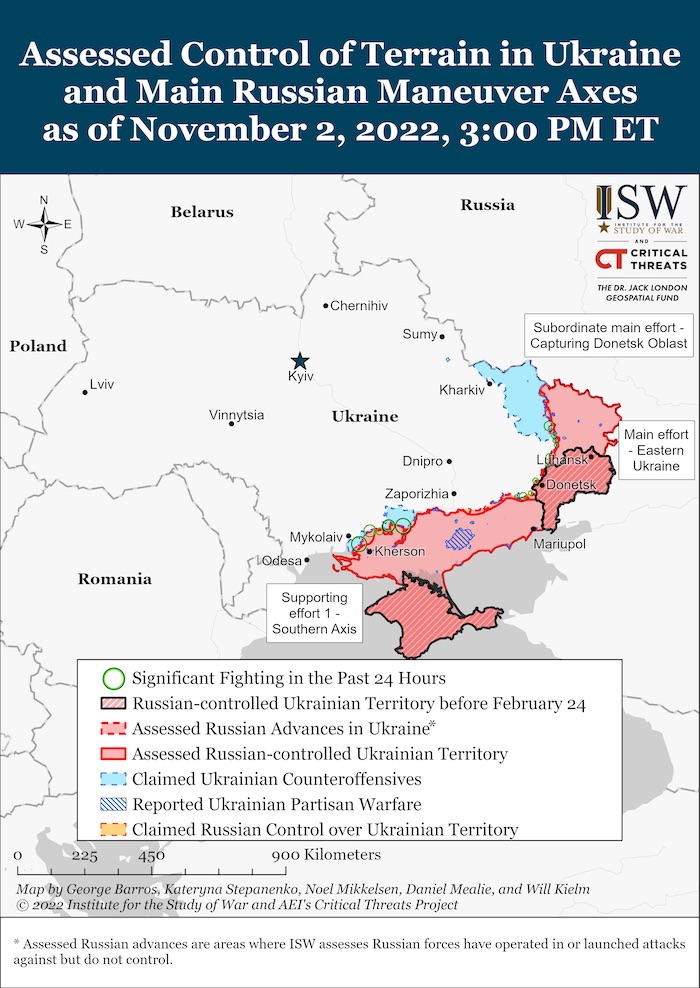
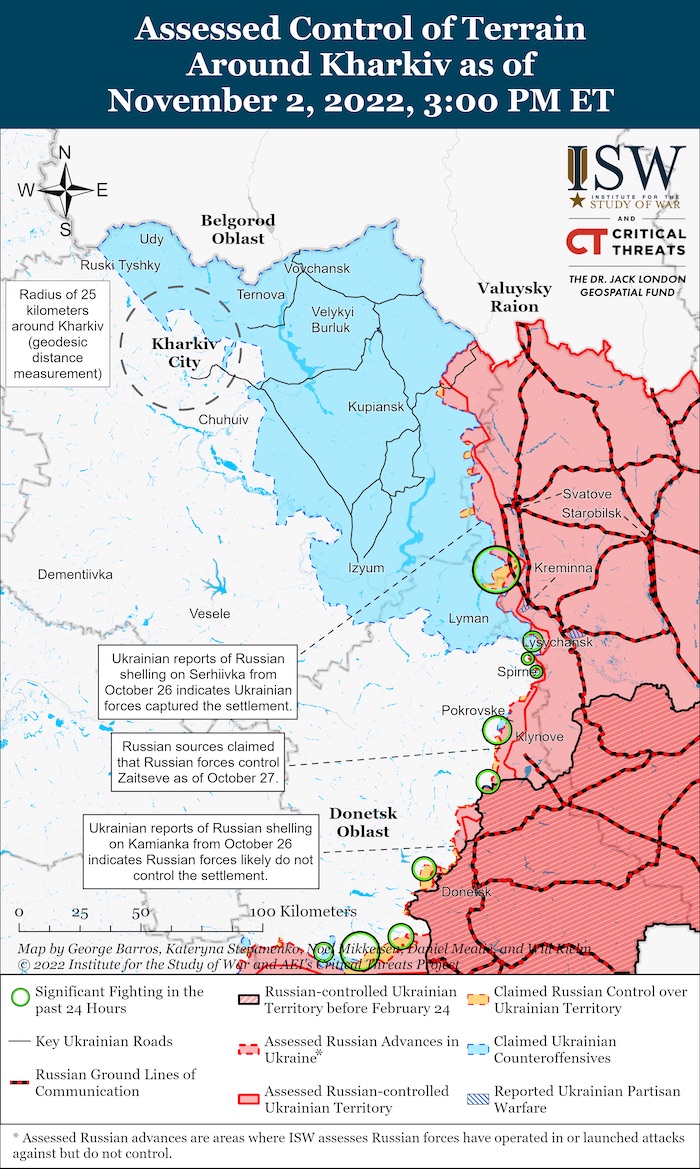
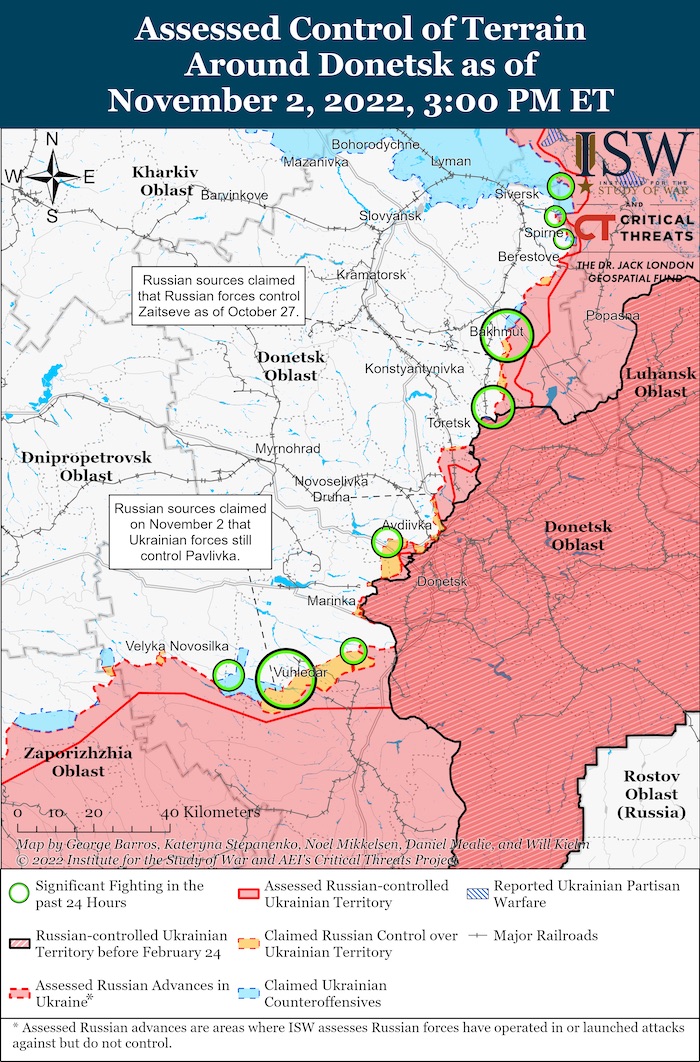
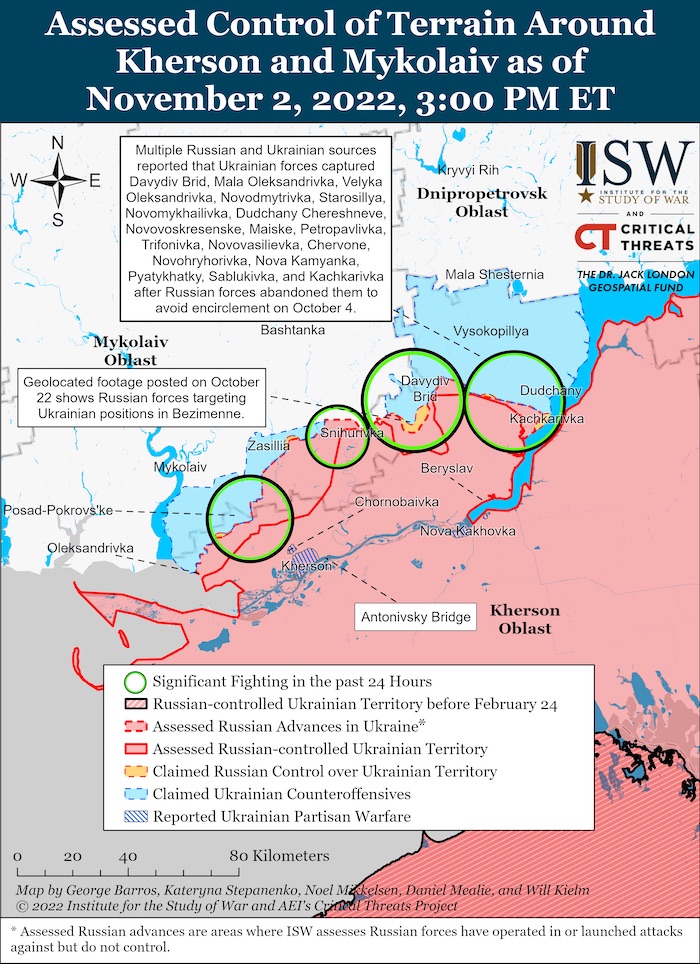
Military Updates
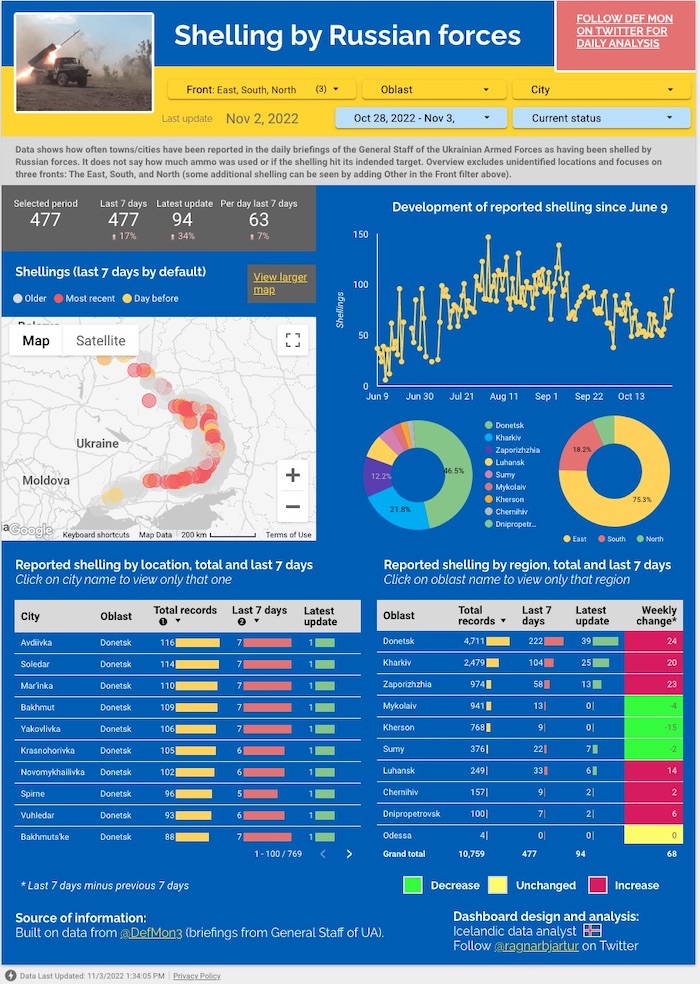
Ukrainian air defenses shoot down 12 of 13 Iranian-made Shahed-136 drones in Russia's night attack
Units of Air Commands East and Center destroyed them between 23:00 and 1:00.https://t.co/G7kDj8gxkB
— Euromaidan Press (@EuromaidanPress) November 2, 2022
Three Russian MiG-31K aircraft and missile containers are still in Belarus, according to satellite images. Three supersonic fighter interceptors MiG-31K of the VKS of the Russian Federation can carry Kh-47M2 "Kinzhal" hypersonic missiles and are capable of launching them at a distance of 2000 km. Several missile containers can store Kinzhal missiles.
Russian Military Leaders Discussed Use of Nuclear Weapons, U.S. Officials Say - NYT
The conversations alarmed the Biden administration because they showed how frustrated Moscow had become over its battlefield setbacks in Ukraine.https://t.co/xg7nPVkTiK
— Euromaidan Press (@EuromaidanPress) November 2, 2022
The US military started monitoring the delivery of Western weapons in Ukraine, a senior Pentagon official said at a briefing. A small number of the US military have recently begun conducting inspections in Ukraine to make sure the military is properly accounting for Western-provided weapons. The official did not specify exactly where the inspections were taking place or how close American troops were to the front. US personnel cannot carry out inspections "close to the front lines," he said, but specified that they are located where security conditions permit.
Regional Updates
Last night, Russian troops shelled Donetsk's Toretsk damaging two hospital buildings, homes, garages.
📷https://t.co/y2jqTSKW2k pic.twitter.com/71WBYv9tBD
— Euromaidan Press (@EuromaidanPress) November 2, 2022
In Kyiv Oblast:
Damaged in the first days of Russia's full-scale invasion, the high-rise in Kyiv's neighborhood of Pozniaky now looks much better than before the invasion.
📷 before and after, via https://t.co/1wcbxwam28 pic.twitter.com/0ZufL73aTD
— Euromaidan Press (@EuromaidanPress) November 2, 2022
In Dnipropetrovsk Oblast, In Kryvyi Rih, a drone hit an energy infrastructure facility. The damage is significant. Several areas of the city are without electricity and water.
Russia has attacked Kryvyi Rih, Dnipropetrovsk Oblast, with a kamikaze drone, mayor Vilkul reported - https://t.co/IsMjPDr9Kj
Also, Zaporizhzhia outskirts "have been attacked by the enemy," Zaporizhzhia Oblast Head Starukh says -https://t.co/2EjgmmoMPt
— Euromaidan Press (@EuromaidanPress) November 2, 2022
In Zaporizhzhia Oblast, the Russian military attacked the suburbs of Zaporizhzhia city, explosions reported.
In Cherkasy Oblast, one kamikaze drone hit an infrastructure facility. Two Shahid drones were shot down by air defense forces.
Red executioner's cap put on monument to Catherine II in Odesa
"An eloquent installation appeared on marker [symbol] of Putin's bloody '[Russian] world'," Head of S Dep
of Remembrance Institute. The monument was repeatedly doused with red paint in Sep https://t.co/tjHH67fg9M pic.twitter.com/TSIfl2O0Bi— Euromaidan Press (@EuromaidanPress) November 2, 2022
Three Russian X-59 cruise missiles fired in the direction of Odesa were shot down
They were fired from Su-30 aircraft from the direction of the Black Sea, City Council reported https://t.co/y7jgJPX254
— Euromaidan Press (@EuromaidanPress) November 2, 2022
Russian river crossing, ammo dump, fuel storage hit at occupied Kherson - media
In detail: https://t.co/ibHyLDk3mC
📹Hits on the Antonivskyi bridge and nearby makeshift crossing, via https://t.co/KAeTT7TaU7 pic.twitter.com/Pd0WE6DHWp— Euromaidan Press (@EuromaidanPress) November 2, 2022
Oct 31 satellite imagery confirms destruction of 3 helicopters in Veretye air base in Russia's Pskov Oblast
Earlier 🇺🇦intel said an explosion destroyed 2 Ka-52s & a Mi-28N, "significantly damaged" 2 more helicopters (https://t.co/6Ru5eksEuv). Read @GeoConfirmed thread: https://t.co/NU40wWKww9 pic.twitter.com/OwIYijfJz4
— Euromaidan Press (@EuromaidanPress) November 2, 2022
According to British Defence Intelligence, (last 48 hours):
https://twitter.com/DefenceHQ/status/1588130284205215744
- Russian soldiers serving in Ukraine are likely frustrated that they are forced to serve in old infantry combat vehicles which they describe as aluminium cans. In mid-October, in the face of Ukrainian offensives, Russian armoured vehicles losses increased to over 40 a day: roughly equivalent to a battalion’s worth of equipment.
- In recent weeks Russia has likely resorted to acquiring at least 100 additional tanks and infantry fighting vehicles from Belarussian stocks. Armoured units and artillery are central to Russia’s way of war; the force in Ukraine is now struggling partially due to difficulties in sourcing both artillery ammunition and sufficient serviceable replacement armoured vehicles.
Losses of the Russian army
As of 3 November, the approximate losses of weapons and military equipment of the Russian Armed Forces from the beginning of the war to the present day:
These are the indicative estimates of Russia’s combat losses as of Nov. 3, according to the Armed Forces of Ukraine. pic.twitter.com/AnWEnKUUuV
— The Kyiv Independent (@KyivIndependent) November 3, 2022
Humanitarian
About 7,000 people are missing in Ukraine, said Deputy Defense Minister Hanna Maliar.
Environmental
35-45% of the Ukrainian energy system is damaged by the constant Russian air strikes, said the director of the Energy Research Center Alexander Kharchenko. “Objects are being restored very quickly, then a new wave of missiles arrives, and we have new destroyed objects. Therefore, it is difficult to fix any specific indicator indicating the current level of damage, but they are really somewhere between 35% and 45%,” he said. According to him, the Russians have changed tactics: they are not hitting protected dams or turbines, but transformer substations, which makes it difficult to transport electricity. At the same time, Kharchenko believes that the “blackout” does not threaten the Ukrainian energy system.
Russia resumes UN-brokered Ukraine grain-export deal in abrupt reversal - Bloomberg
Russia had announced its pullout from the deal on Oct29, but Ukraine, Turkey, and the UN continued sending ships via the "green corridor." https://t.co/eSI0gHUZlZ
— Euromaidan Press (@EuromaidanPress) November 2, 2022
Ukraine's energy workers restore power supply after Russian shelling remarkably fast
In October, it took from three to 28 hours to restore the power supply. Russia attacked energy facilities in Ukraine 103 times during the full-scale war https://t.co/MrGm3hF6gq pic.twitter.com/H464gRA9um
— Euromaidan Press (@EuromaidanPress) November 2, 2022
Support
US historian @TimothyDSnyder becomes UNITED24 platform ambassador launching 'Shahed Hunter' fundraiser
Among the UNITED24 ambassadors are athletes Andriy Shevchenko and Elina Svitolina, actor Mark Hamill, singer Barbra Streisand, astronaut Scott Kellyhttps://t.co/mM8YQRWwDc https://t.co/XgKwtNI8Hz
— Euromaidan Press (@EuromaidanPress) November 2, 2022
Nearly 9000 Ukrainian servicemen have been issued more than 40 items of standard and winter kit from the British Army to be prepared for the harsh winter ahead, the Ministry of Defence of the UK informs https://t.co/ZcuQCQIGEx
— Euromaidan Press (@EuromaidanPress) November 2, 2022
Foreign Minister of Spain Jose Manuel Albarez arrived in Ukraine on an official visit.
Spain to supply SAM Aspide battery, four Hawk air defense systems, artillery pieces, shells to Ukraine - Ukraine FM Kuleba
Kuleba said it in Kyiv today at a briefing with his Spanish counterpart, José Manuel Albareshttps://t.co/SG6dFladt6
— Euromaidan Press (@EuromaidanPress) November 2, 2022
The United States allocated $55 million to Ukraine to repair and maintain the heat supply infrastructure. More than 1,600 generators, water treatment systems and other heating equipment will also be provided. “The United States Agency for International Development (USAID) has announced a new $55 million package to help Ukraine repair and maintain the heating infrastructure in 19 regions of Ukraine, reaching up to 7 million Ukrainians,” said US State Department spokesman Ned Price during the briefing.
Poland leaves Russian embassy without holiday resort near Warsaw
Polish authorities took over a holiday resort north of Warsaw leased by the Russian embassy. The Soviet then Russian embassy had been renting the property since the 1980s.https://t.co/EHKgbk1ueg
— Euromaidan Press (@EuromaidanPress) November 2, 2022
New Developments
North Korea is secretly supplying Russia with artillery shells, as stated by the White House strategic communications coordinator John Kirby. “In September, the DPRK publicly denied that it intended to supply ammunition to Russia. However, our information indicates that the DPRK is secretly supplying a significant amount of artillery shells for Russia's war against Ukraine,” he said. North Korea is trying to hide its final destination and creates the appearance that weapons are supplied to the countries of the Middle East or North Africa. The US will monitor whether these shipments are received, Kirby added.
Ukrainian President Zelenskyy had a phone call with his Turkish counterpart @RTErdogan, key topics: grain deal, return of Ukrainian prisoners from russian captivity.https://t.co/HZ9ijKE5QC
— Euromaidan Press (@EuromaidanPress) November 2, 2022
Poland started the construction of a fence on the border with the Kaliningrad region of the Russian Federation. Minister of Defense Mariusz Blaszczak specified that the fence will be made of barbed wire, its height will be 2.5 meters and width - 3 meters. The system at the border will consist of three rows of fences. Blaschak explained that the decision to build the fence was connected with the opening by the Russian side of the airport for aircraft from the Middle East and North Africa in the Kaliningrad region. According to him, this creates a threat of an increase in the migration flow to Poland. Poland has completed the construction of a 140 km long wall with Belarus recently.
Ukrainians choose to respond to Russia's nuclear threats in different ways: from buying protective gear to sardonically laughing in the face of mortal danger via memes and jokes about "orgy" plans on the day of a possible attack. https://t.co/lsFgfBMuzw
— Euromaidan Press (@EuromaidanPress) November 2, 2022
Italy put the delivery of the next, sixth, military aid package to Kyiv on hold, claiming that "support remains," the Il Messaggero newspaper reported, citing government sources. The issue must first be agreed upon with NATO. “Only then will we understand what Kyiv needs and what weapons we can supply,” sources in the Italian government said.
Assessment
On the war.
The Institute for the Study of War has made the following assessment as of 2 November, 2022:
Russian force generation efforts combined with Western sanctions are having long-term damaging effects on the Russian economy, as ISW has previously forecasted. Financial experts told Reuters that the Kremlin will face a budget deficit that will “drain Moscow’s reserves to their lowest level in years” due to projected decreases in energy revenue, sanctions, and the cost of Russian mobilization.[1] One expert predicted that payouts to mobilized men including social benefits may cost the Kremlin between 900 billion rubles and three trillion rubles (around $14.6-$32.4 billion) in the next six months. The number does not account for payouts to other categories of servicemen within the Russian forces such as BARS (Combat Army Reserve), volunteer battalions, and the long-term commitment to veterans' payments to contract servicemen, volunteers, non-military specialists who moved to occupied territories, and proxy fighters.[2] ISW previously estimated that one volunteer battalion of 400 servicemen costs Russia at least $1.2 million per month excluding enlistment bonuses and special payments for military achievements.[3]
The Kremlin is continuing to rely heavily on financially incentivizing Russians to fight in Ukraine, which will likely continue to strain the Russian economy for decades. Russian officials have been promising salaries to volunteers and mobilized men that are more than twice the average Russian civilian salary before and during Russia’s full-scale invasion of Ukraine.[4] The Kremlin has been attempting to deflect part of the cost of the force generation effort onto Russian federal subjects but will likely need to tap into the federal budget more heavily soon. United Russia Party Secretary Andrey Turchak, for example, stated that Russian servicemen from all regions must receive uniform benefits and noted that the federal government must cover the difference if the federal subject is unable to fully compensate all participants of the “special military operation.”[5] Donetsk People’s Republic (DNR) Head Denis Pushilin even acknowledged that there are insufficient measures in place to support mobilized personnel and their families in occupied Donetsk Oblast during a United Russia meeting.[6]
The Kremlin is already facing challenges in delivering promised compensation, challenges that are increasing social tensions within Russian society. Russian Telegram channels released footage of mobilized men in Ulyanovsk protesting payment issues.[7] Other footage from the Chuvashia Republic shows a presumably Russian local official yelling at protesting mobilized men that she had not promised them a payment of 300,000 rubles (about $4,860).[8] Families of mobilized men publicly complained to Voronezh Oblast Governor Alexander Guseyev that they have not received promised compensation of 120,000 rubles (about $1,945).[9] The Kremlin will need to continue to pay what it has promised to maintain societal control and some resemblance of morale among Russia’s ad hoc collection of forces. ISW has also reported that the Kremlin is igniting conflict within Russian military formations amalgamated from different sources by offering different payments, benefits, and treatment.[10] Social media footage from October 31, for example, showed a physical fight between contract servicemen and mobilized men reportedly over personal belongings and military equipment.[11]
Russian President Vladimir Putin’s calls for a competitive Russian military industry are divorced from the reality of Russian supply chain and defense industrial base issues. Putin stressed on November 2 during a meeting of the Coordinating Council for the Russian Armed Forces that it is important that the Russian government ensures active competition between Russian military arms manufacturers.[12] Putin’s calls contrast with recent reporting that Russia has purchased weapons systems from Iran and North Korea to support its war effort in Ukraine.[13] US National Security Council spokesman John Kirby announced on November 2 that the American intelligence community believes that North Korea is covertly supplying Russia with artillery shells.[14] ISW previously reported that Iranian shipments of drones and possible ballistic missiles to Russia will likely further increase Russian reliance on Iranian-made weapons systems.[15] Russia has likely negotiated the weapon shipments with Iran and North Korea because it has significantly depleted its stock of munitions in air, missile, and artillery strikes over the course of the war in Ukraine and cannot readily restock them. Russia’s reliance on isolated and heavily sanctioned states for critical weapons systems does not support Putin’s demand that the Russian military industry becomes highly competitive and meets the needs of the Russian Armed Forces in any short period of time.
Russian officials announced that occupation authorities began integrating the Zaporizhzhia Nuclear Power Plant (ZNPP) into the jurisdiction of Russian nuclear power plant operator Rosenergoatom on November 2.[16] Russian Deputy Foreign Minister Andrey Rudenko claimed that ZNPP personnel who are “critical for the work of the ZNPP” signed contracts with Rosenergoatom and that Russian authorities are exploring the creation of a security zone around the ZNPP.[17] Ukraine’s Energoatom stated on October 28 that only 100 of the 6,700 Ukrainian personnel remaining at the ZNPP plant have signed new contracts with the Russian energy agency Rosatom (out of 11,000 personnel before February 24).[18] The Ukrainian State Inspectorate of Nuclear Regulation stated that Russian forces built an unknown structure at one of seven spent nuclear fuel storage sites at the ZNPP in violation of nuclear safety standards.[19] As of this publication, the International Atomic Energy Agency (IAEA) has not issued a statement condemning the formally announced illegal Russian takeover of the operation of the ZNPP or addressed the likelihood that Russia will demand formal IAEA recognition of Russian control over the ZNPP and thereby de facto recognition of the Russian annexation of occupied Ukrainian territory.
Russian and Belarusian officials continue to highlight bilateral defense cooperation between Russia and Belarus as a means of perpetuating the long-standing information operation that Belarus will enter the war in Ukraine on behalf of Russia. Belarus’ entry into the war remains highly unlikely, as ISW has previously assessed. Belarusian Defense Minister Viktor Khrenin announced on November 2 that Russia and Belarus held the annual meeting of the Joint Board of the Ministries of Defense with the purpose of strengthening the “joint military potential” of the Russia-Belarus Union State to counter “challenges and threats of a military nature” posed by NATO.[20] Khrenin’s statement is likely meant to signal continued Belarusian loyalty to Russia and present an image of Belarusian-Russian military unity to the West. As ISW has previously assessed, Belarus' entry into the war remains highly unlikely due to the array of domestic ramifications such an action would have on President Aliaksandr Lukashenka’s regime, as well as limited Belarusian military capabilities.[21] The meeting of the Joint Board of the Ministries of Defense is therefore a continuation of a concerted effort on the part of both Belarus and Russia to perpetuate an information operation that presents the threat of the Union State as imminent in order to pin Ukrainian troops against the northern border and pollute the information space.
Key Takeaways
- Russian force generation efforts combined with Western sanctions are having long-term damaging effects on the Russian economy, as ISW has previously forecasted.
- Russian President Vladimir Putin’s calls for a competitive Russian military industry are divorced from the reality of Russian supply chain and defense industrial base issues.
- Russian officials announced that occupation authorities began integrating the Zaporizhzhia Nuclear Power Plant (ZNPP) into Russian jurisdiction.
- Russian and Belarusian officials continue to perpetuate the long-standing information operation that Belarus will enter the war in Ukraine on behalf of Russia, but Belarus’ entry into the war remains highly unlikely, as ISW has previously assessed.
- Russian sources claimed that Ukrainian forces continued to conduct counteroffensive operations in the directions of Svatove and Kreminna, and Russian forces conducted offensive operations to constrain Ukrainian forces.
- Russian forces continued defensive operations along the Dnipro River while Ukrainian forces continued their interdiction campaign.
- Russian forces continued to conduct ground assaults near Bakhmut and Donetsk City.
- Russian forces continued mobilization efforts and advertising for volunteer battalions while struggling with low morale.
- Russian occupation authorities continued to forcibly relocate Kherson Oblast residents, nationalize Ukrainian enterprises in occupied territory, and forcibly deport Ukrainian children to Russia.


